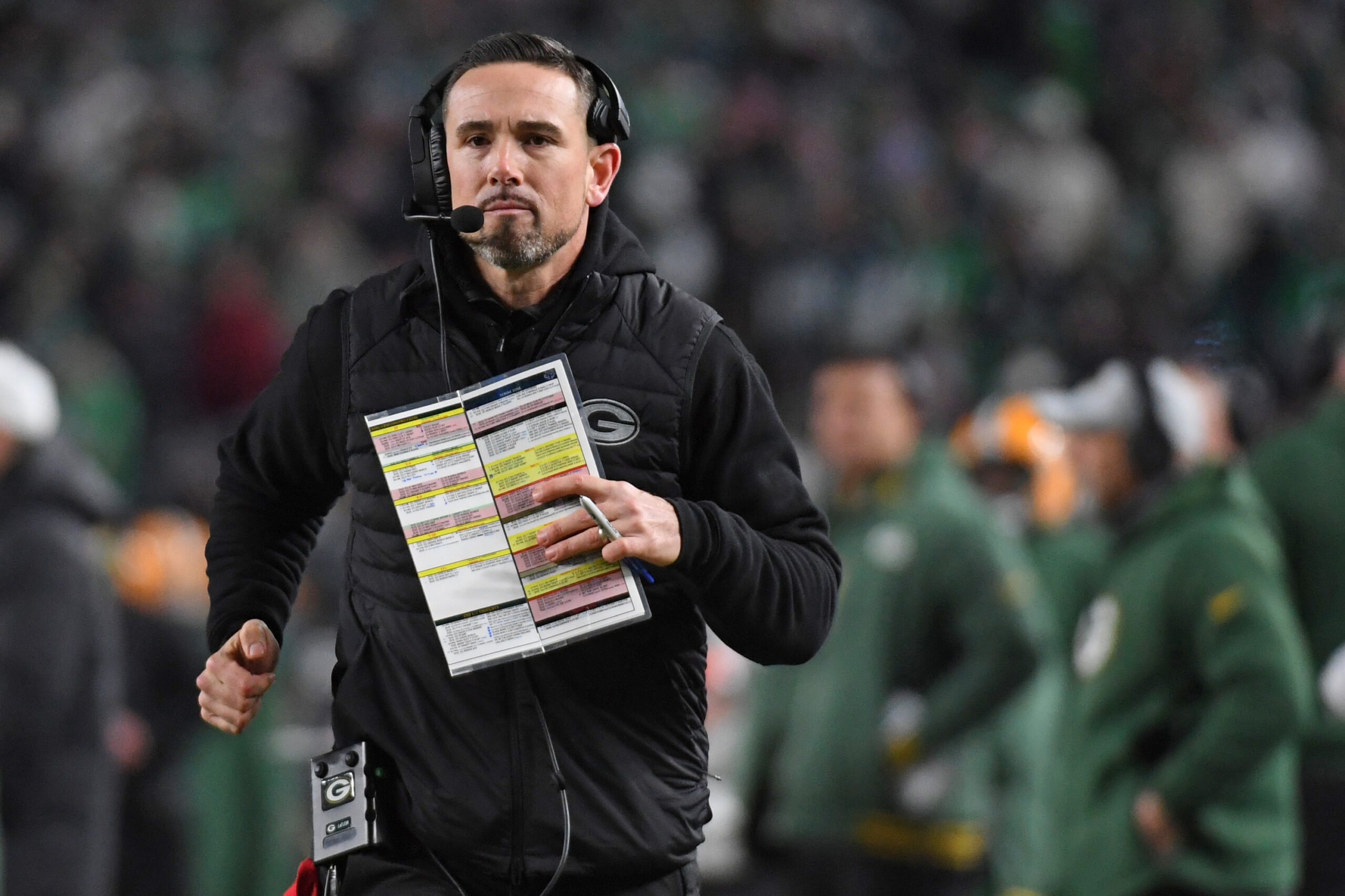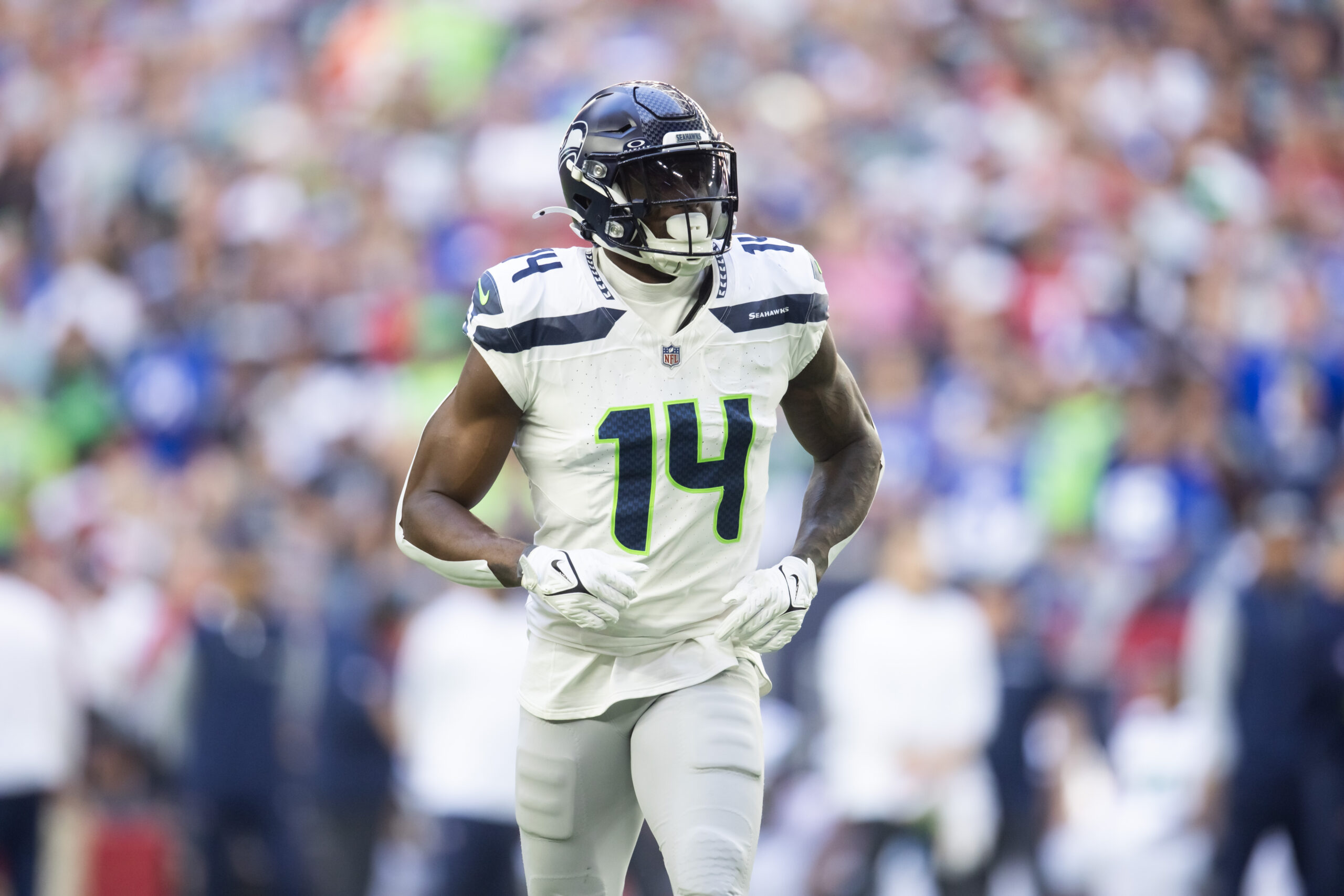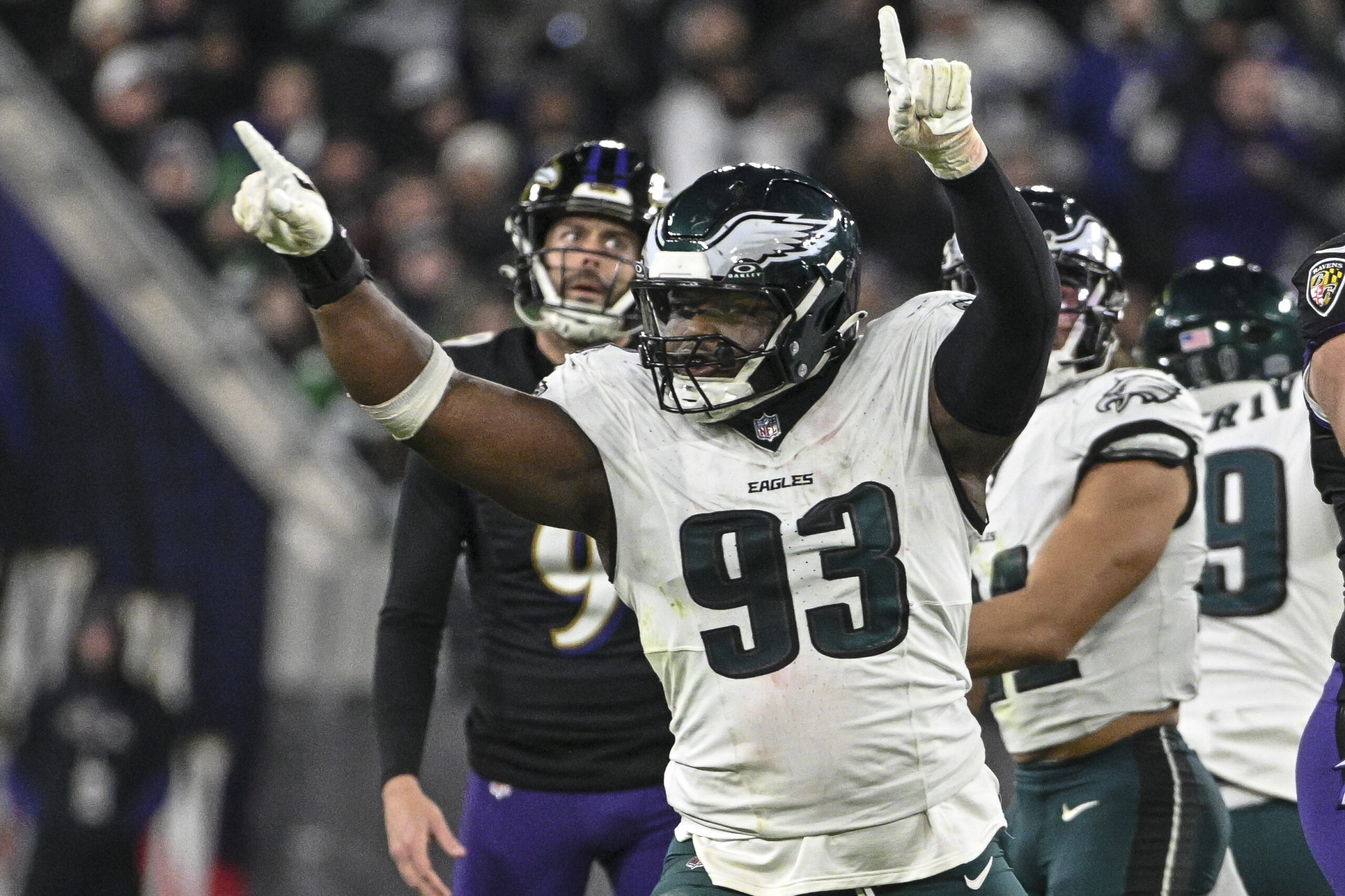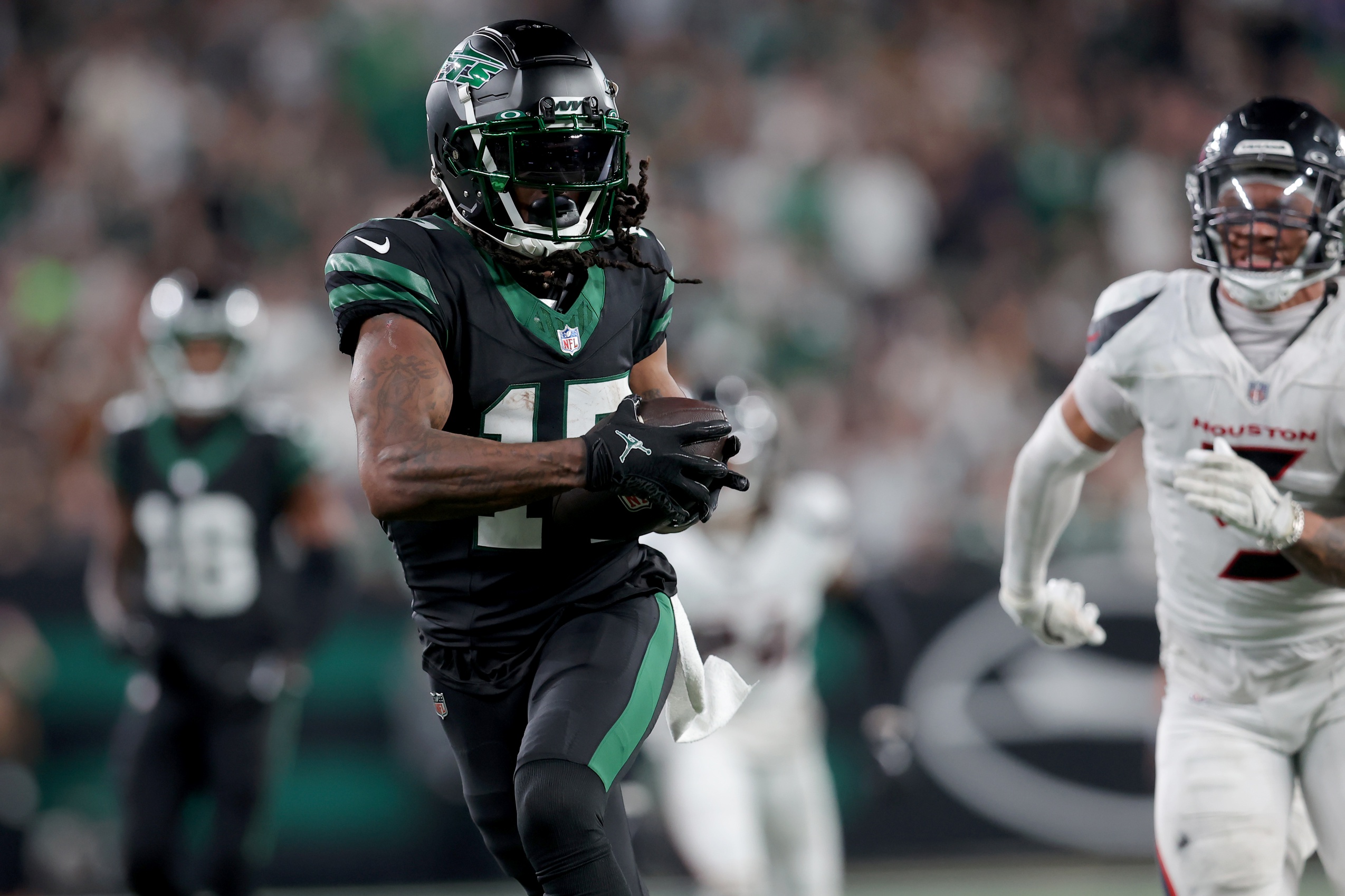NFL Analysis
9/30/24
23 min read
1st & 10 Week 4: Ravens' Statement Win, Jayden Daniels Keeps Going, Vikings Stay Hot & More
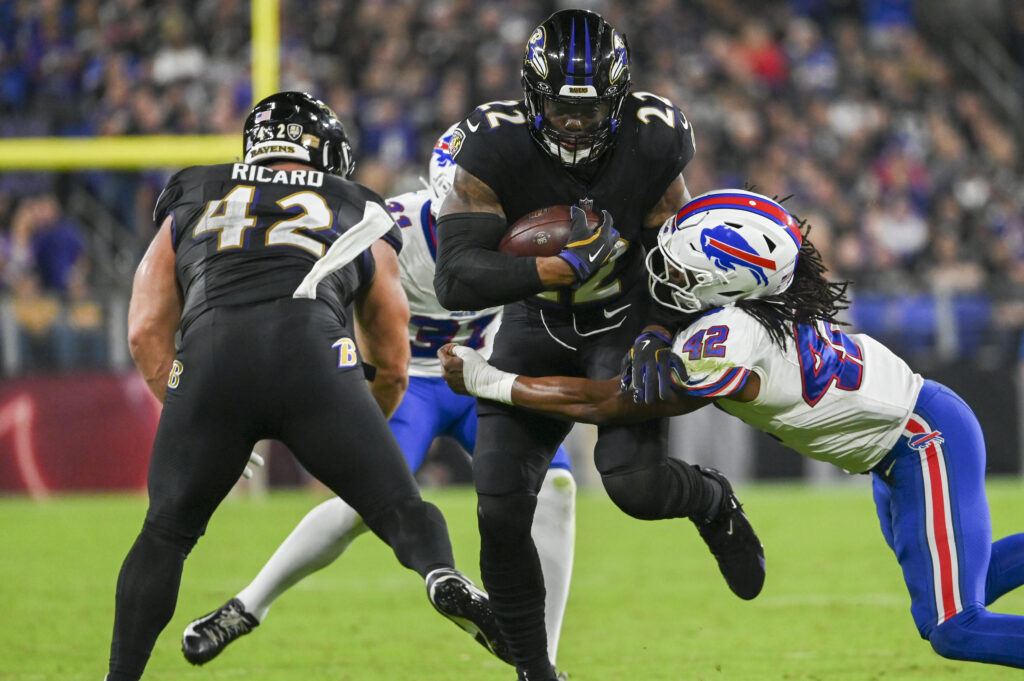
Week 4 gave us a few surprises. In an early slate that looked like it could have been filled with uncompetitive blowouts, we got a bunch of close games. Then, we ended the night with a game we all thought would be close but wasn't. There's a lot to get into this week.
Each week, 1st & 10 will bring you a Monday morning in-depth breakdown of everything you need to know from Sunday’s slate of games. We’ll fill this column with stats, film, and plenty of words to keep you covered on anything you might have missed or want to dive deeper into from Sunday.
All stats provided by TruMedia unless noted otherwise.
>> READ MORE: Week 4's Biggest Winners, Losers
1st & 10 NFL Week 4
1. The Ravens Made a Heavy Statement
Through three weeks of the 2024 season, Josh Allen looked like he would become the MVP favorite. However, the 2023 MVP made sure that talk would at least be delayed a bit.
In a meeting between two of the league’s best teams, the Baltimore Ravens looked dominant in a 35-10 win against the Bills. Two weeks after a loss to the *checks notes* Raiders and a week after letting the Cowboys make an attempted comeback in the fourth quarter, the Ravens looked like the top-tier contender many expected them to be this season.
It started almost immediately with an 87-yard run from Derrick Henry on Baltimore’s first play from scrimmage after forcing a Buffalo punt.
According to Next Gen Stats, Henry reached a top speed of 21.29 miles per hour, the eighth-fastest top speed since 2018. Top speed can be an overrated metric because it’s often just measuring which players get open space to run — remember the Daniel Jones top speed against the Eagles from a few years ago — but Henry is listed at 6-foot-2 and 247 pounds. The fact that he’s continually getting that open space to hit full speed at that size is incredible.
The only player with more plays of more than 20mph with the ball since 2018 is Tyreek Hill.
Another element of that run was Henry lined up in pistol. With Henry right behind Lamar Jackson, the Bills’ defenders couldn’t get a definitive read on where the run was likely to go, and they were immediately driven away by Baltimore’s blocking. The Ravens used a season-high 13 percent of snaps in pistol against the Bills.
Even if we take away the 87-yard run, Henry had an impressive day on the ground with 23 carries and 112 yards outside of the first drive.
Henry had 10 carries from 22 personnel, another six from 21, and three from 20. During the past two weeks, the Ravens have leaned into more backs on the field, often with that being FB Patrick Ricard.
That heavier personnel brought the Bills into heavier defensive personnel, which is something they do not do often. Going into this game, the Bills used nickel personnel on 78.3 percent of snaps (fourth in the league) and dime on the other 21.7 percent of the time. They had not played a snap of base defense.
Yet, while missing Matt Milano and Terrell Bernard, the Bills matched in base on 42.4 percent of snaps when the Ravens came out in a two-back set on Sunday night. With two backs on the field, the Ravens averaged 9.0 yards per play (87-yard touchdown included). Against base defense, the Ravens averaged 7.1 yards per play with a 75 percent success rate.
On a five-yard touchdown pass to Henry to start the second quarter, the Ravens came out in 22 personnel. Motion from Ricard drew the whole defense to the left before Henry snuck out to the right for an easy catch.
— Dan Pizzuta (@DanPizzuta) September 30, 2024
Later on, the Ravens had a second-and-7 from the Buffalo 19-yard line in the second quarter. Baltimore came out in 21 personnel, and Buffalo matched with nickel.
Still, the Ravens used the same concept. Zay Flowers and Rashod Bateman were tight to the right. Before the snap, Flowers motioned to the left, which carried the defense. That allowed Justice Hill to get down the field to the right, with the linebacker having too far to cover horizontally to catch up with Hill, who had a 19-yard touchdown.
— Dan Pizzuta (@DanPizzuta) September 30, 2024
So much worked for Baltimore offensively. Jackson added 54 yards and a touchdown on the ground while he averaged 0.61 EPA per play overall.
The Ravens have found an identity in the past two weeks that leans into the threat of Jackson and Henry in the same backfield. It’s left the Cowboys and Bills failing to adequately defend against either. That opened up the passing game, which looked much better and had a rhythm on Sunday night.
For the second week in a row, Jackson did not attempt a pass into a tight window, defined as a yard or fewer of separation, according to Next Gen Stats.
On the other side of the ball, the Ravens kept Allen to one of his worst career games. Last week’s dominant win against the Jaguars was Allen’s third-best success rate. Sunday night against the Ravens was his third-lowest (24.3 percent).
Coverage was good, and Allen threw into a tight window on 24.1 percent of his pass attempts. He held onto the ball for more than three seconds on average and was pressured on 40 percent of his dropbacks. After the Bills had so successfully dictated how they would play offense in the first three weeks with quicker passes over the middle of the field, the Ravens did not allow that.
After a 0-2 start, the Ravens are back to 2-2 and face the Bengals and Commanders in the next two weeks. One of those matchups looks easier, and it’s not the one we would have expected coming into the season…

2. Washington’s offense is rolling
Each week, the Washington Commanders' offense has revealed a little more, expanding an offense that has been humming for four weeks. In a week when the Commanders finally punted and had their first turnover of the season, there was little slowing it down in a 42-14 win against the Arizona Cardinals.
Jayden Daniels went 26-of-30 for 233 yards, and he added 47 yards with a touchdown on the ground. His 0.69 EPA per play led the week, as did his 63.2 percent success rate.
There have been three games by rookie quarterbacks with at least 0.60 EPA per play and a 60 percent success rate since 2000. Daniels has had two of them in the past two weeks. The other came from Marcus Mariota in Week 1 of 2015, but with only 15 pass attempts.
Daniels also now leads the league in EPA per play for quarterbacks at 0.42; the next-highest quarterback is at 0.27. The gap between Daniels and No. 2 is bigger than the gap between No. 2 and No. 6.
The Commanders split the difference between the screens and scrambles offense of the first two weeks and the downfield shots we saw last week against the Cincinnati Bengals. Daniels only had a 5.8-yard aDOT, which is closer to the first two weeks of the season, but it was 10.1 yards in the first half before the offense slowed things down with a big lead in the second half.
Take a look at how the offense has evolved based on where Daniels has thrown the ball in the past four weeks.

This week, there was more work in the intermediate middle of the field. Daniels went 6-for-6 on throws between 11-19 air yards and has only missed one of 18 throws to that depth so far this season.
There was also more play-action usage, which allowed Daniels to stay longer and process from the pocket. Washington upped the play-action usage to manipulate the defenders in coverage since fewer were coming at Daniels in this game.
Arizona was 22nd in blitz rate in the first three weeks of the season, mostly leaving their front to sim pressures and creepers, but the Cardinals didn’t even try to come at Daniels with just a 16.7 percent blitz rate.
We have a four-game sample of defenses pulling away from blitzing the rookie while Washington is taking advantage of fewer pass rushers by going heavier into play-action. That’s also coincided with the Commanders shifting to heavier personnel.
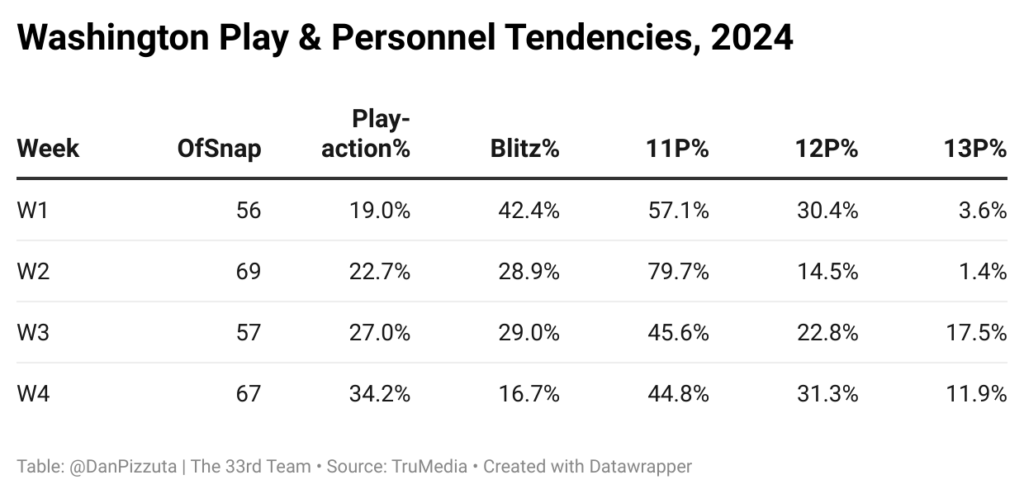
It’s not just the passing offense that’s working. The run game was expected to be good under Kliff Kingsbury, and it has lived up to the hype, regardless of who is taking the handoff.
Brian Robinson had 101 yards and a touchdown on 21 carries, while Jeremey McNichols, getting play time because Austin Ekeler was out with a concussion, had 68 yards and two touchdowns.
McNichols averaged 2.5 yards before contact per rush and was only contacted within a yard of the line of scrimmage on two of his eight carries. That’s manipulating the fronts to create running room.
On two of the touchdown runs, the Commanders had a fun wrinkle: The back started in pistol and then came up to an offset position.
On the Robinson touchdown, the shift moves Zaven Collins toward the offset side, which puts him right in line to be blocked by the left guard in the gap the run is intended to target.
— Dan Pizzuta (@DanPizzuta) September 30, 2024
Then, on McNichols's 27-yard touchdown, the shift from pistol to offset brings in Mack Wilson (2) and Budda Baker (3), who show a blitz from the right side of the offense to the offset side. However, the run goes the other way behind two pulling guards.
McNichols TD dots pic.twitter.com/oMjcp3who9
— Dan Pizzuta (@DanPizzuta) September 30, 2024
Daniels also got involved on the ground with a nine-yard touchdown on a sweep early in the third quarter.
Jayden Daniels sweep pic.twitter.com/cl2UweGbVX
— Dan Pizzuta (@DanPizzuta) September 30, 2024
Daniels has been in complete control of the offense, regardless of the version, since he took the field in Week 1. He’s off to the best start of a career we’ve seen in the modern game.
Here are the top rookies by EPA per play in their first career starts.
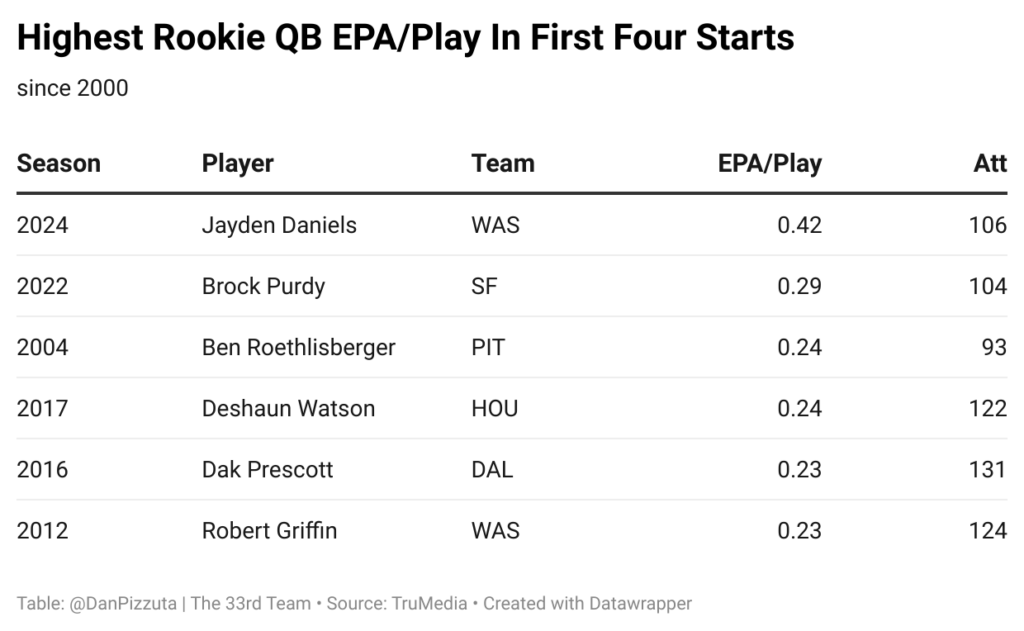
We had to say career starts because a list of rookie quarterbacks who started immediately and had success during the first four weeks of the season is even shorter. Of the list above, only Prescott’s and Griffin’s first four career games came during the first four weeks of the season.
Because there have been so few negative plays on offense — Daniels threw his first interception in this game, Washington’s first turnover of the season — and everything keeps moving, the success has been nearly unprecedented on offense.
The Commanders are averaging 2.0 EPA per drive this season. The only other team since 2000 with a better rate was the 2007 New England Patriots (2.2).
>> READ MORE: Will The Commanders Win The NFC East?
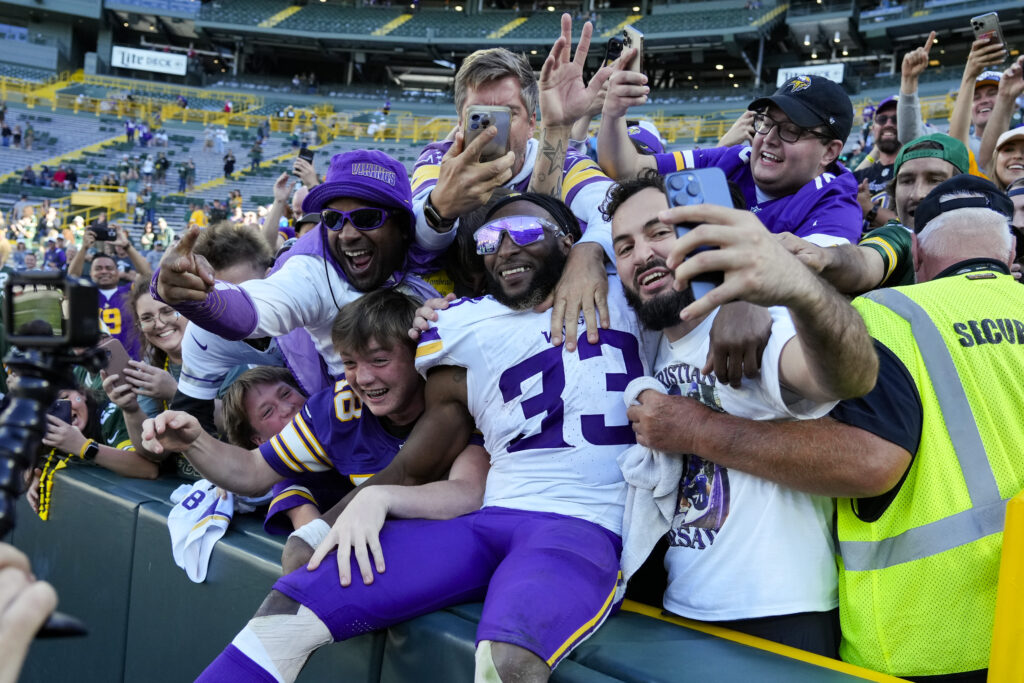
3. Everything Keeps Working For The Vikings
Everything keeps working for the Minnesota Vikings. After a 31-29 win against the Green Bay Packers, the Vikings are 4-0 and tied for the best point differential in the league.
The Vikings jumped out to a 28-0 lead and led 28-7 at halftime before the Packers made it interesting in the second half. However, even during that attempted comeback, Minnesota only dropped to an 81 percent win probability, according to ESPN Analytics.
This was another game with both sides of the ball working as hoped. Early on, the Vikings took advantage of a hindered Green Bay secondary that was without Jaire Alexander and continued to give Sam Darnold easy answers in the passing game.
On a third-and-14 on the opening drive, the Vikings ran a spear concept (dueling deep crossers) out of empty. While one safety stayed deep to defend against a Jordan Addison clearing route and the other stayed on top of the crosser from Justin Jefferson, Jalen Nailor created separation against Eric Stokes (21) and had an opening for a big gain.
— Dan Pizzuta (@DanPizzuta) September 30, 2024
A deep touchdown pass to Jordan Addison shortly followed that up. Motion from TE Josh Oliver (84) brought the safety down, and the deep safety again stayed on top of Justin Jefferson. That allowed Addison the space to run past CB Corey Ballentine.
— Dan Pizzuta (@DanPizzuta) September 30, 2024
Darnold threw passes to nine different Vikings in this game, eight of whom had at least one reception. Jefferson led the way with 85 yards and a touchdown on six receptions and eight targets, but this offensive plan allowed the Vikings to spread the ball around.
Despite a 54 percent success rate, Darnold still finished with negative EPA, partly due to an interception and a lost strip-sack in the fourth quarter. But as has been the case for the Vikings, even when Darnold gets some of those bad tendencies, there has already been enough success that it has yet to truly bite the Vikings, though those turnovers helped spark Green Bay’s comeback attempt.
The Packers' defense was more aggressive in the second half, which caused some trouble for Darnold and stalled the Minnesota offense.

Meanwhile, the Vikings defense tested Jordan Love in his first game back after his MCL injury. The Vikings blitzed Love on 42.9 percent of his dropbacks.
In the first half, the pressure got to the quarterback, and Love took a ton of hits, while he only took one sack. That sack was a big one on third down with a five-man front and a stunt on the edge that freed up Pat Jones.
— Dan Pizzuta (@DanPizzuta) September 30, 2024
However, in the second half, Love sped up his process and was slightly more successful. That included more no-huddle to keep the Vikings from changing too many looks.
Love was 12-of-15 for 0.44 EPA per play in no-huddle in the second half.

Love, who showed up at the game in a Brett Favre jersey, did his best impression of the former Packers quarterback with 389 yards, four passing touchdowns, and three interceptions.
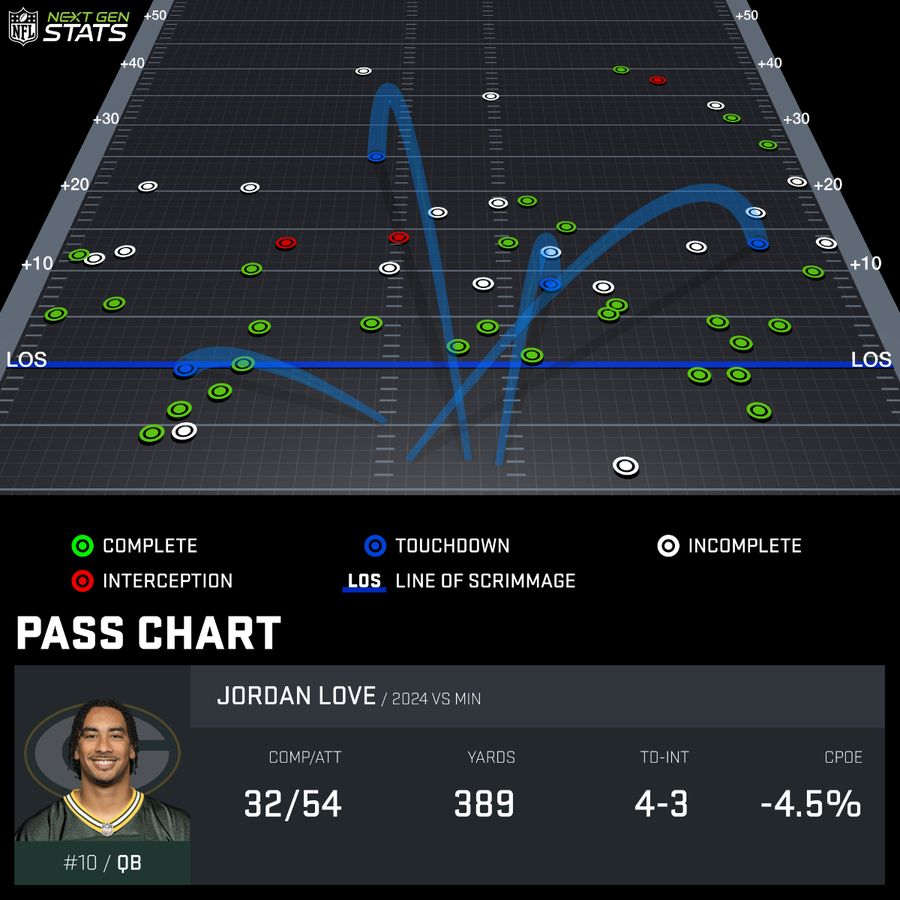
There was certainly a feeling-out period for Love and the Packers offense, and the quarterback appeared to get a bit more comfortable as the game went on, even against the looks Brian Flores presented. That should leave the Packers feeling optimistic going forward, even if the efforts fell short in Week 4.
After stopping the Vikings on downs, the Packers went 96 yards in five plays and 1:22 to score a touchdown and go down by two with 56 seconds left, but a terrible onside kick stopped the comeback.
>> READ MORE: Vikings Are NFL's Unexpected Juggernaut
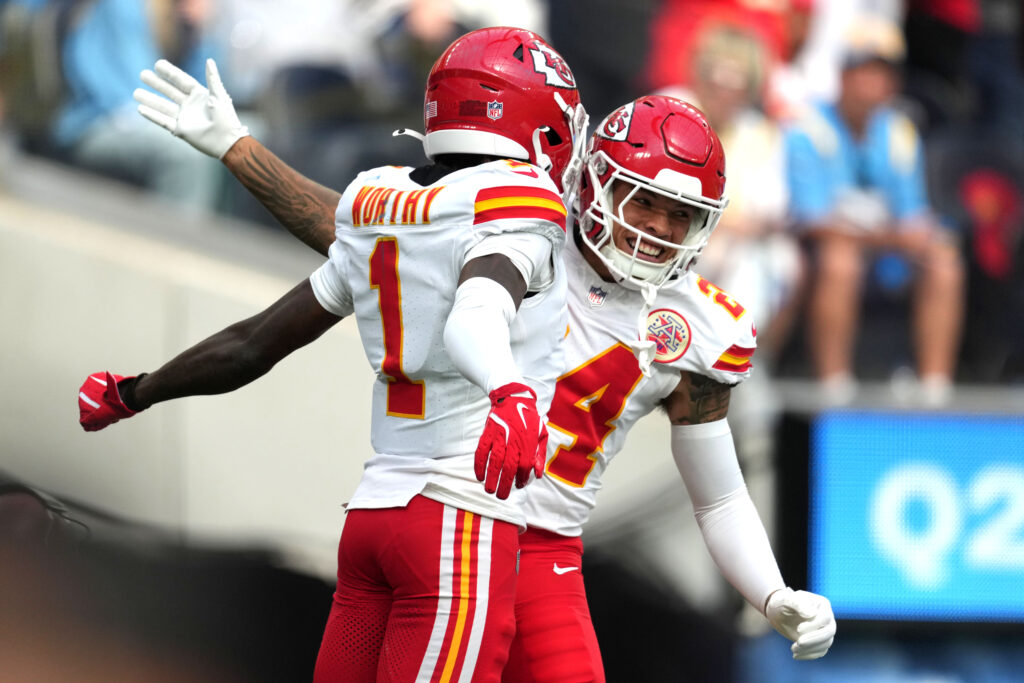
4. Can the Chiefs adjust without Rashee Rice?
The Kansas City Chiefs are 4-0, but it has not been smooth sailing for the two-time defending Super Bowl champs. WR Marquise Brown was lost before the season began with a broken collarbone. In Week 2, Isiah Pacheco suffered a fractured fibula. This week, the Chiefs lost Rashee Rice to what is expected to be a torn ACL that will put the receiver out for the rest of the season.
Rice was the team’s top receiver and one of the best in the league through three weeks, taking advantage of so much of the space in the middle of the field by teams playing against the deep pass.
Even with Rice, this Chiefs offense hasn’t completely hit the ground running in the search for Super Bowl No. 3. While there has been more success than during the regular season last year, it’s nothing like the league-defining explosive offense we’ve seen in previous seasons.
In part, that comes from Kansas City figuring out who plays what role in the offense. At full health, Travis Kelce was going to be eased through the regular season like he was last year. The difference between Kelce’s lack of work in 2023 and 2024 was that in 2023, he was still efficient; he was just seeing the ball less often.
That had not been the case through three weeks in 2024. But that changed in Week 4, when Kelce had seven catches and 89 yards on nine targets and looked more like the top-tier tight end we’re accustomed to seeing.

The Chiefs will have to be more creative for the time being, relying on heavier personnel packages. That’s where Kansas City was at its best last season, and the Chiefs went 24.1 percent 12 personnel and 10.3 percent 13 personnel in their win against the Chargers.
There was also a deep touchdown to Xavier Worthy, the rookie receiver whose speed was used in Week 1 but hasn’t found a consistent role yet in the offense.
One way to beat the two-high coverages is to run right through it, and that’s what Worthy did on his 54-yard touchdown in the second quarter that stopped a drought of a fumble, interception, and three punts from Kansas City to open the game.
Patrick Mahomes hasn’t been playing his best football and had another questionable interception, though he’s still 10th in EPA per play, and the offense sits at ninth in EPA per drive through four weeks.
It is clear, though, that the Chiefs can’t continue with JuJu Smith-Schuster and Skyy Moore playing extended roles as top receivers. A trade could be on the horizon, but to what extent?
Davante Adams feels like a pipe dream, as the Raiders would have to feel comfortable sending him to a division rival. It’s possibly more likely that trade targets will come from a team like the Giants, who have Darius Slayton and Jalin Hyatt, two deep threats who do not get the playing time or production either would want.
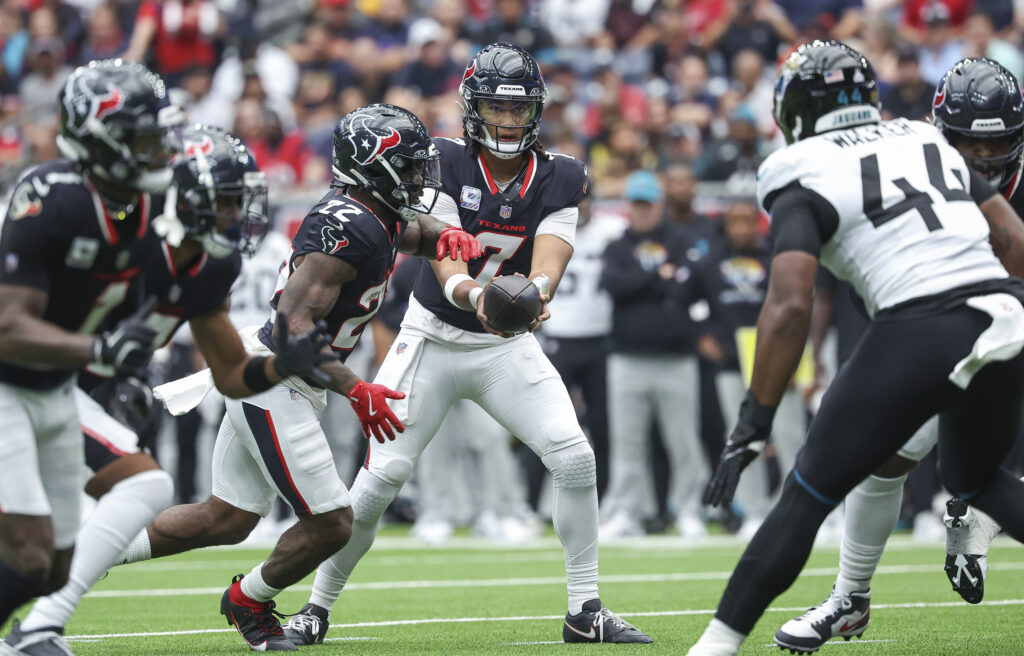
5. Houston still has an early down problem
On 13 third downs in Week 4, C.J. Stroud went 7-of-11 for 96 yards and a touchdown. He averaged 0.73 EPA per play and 8.7 yards per attempt. That’s awesome. It’s also completely unnecessary.
The Houston Texans averaged 8.7 yards to go on third down in Week 4 against the Jacksonville Jaguars. That was the fourth-longest average third down of the week. On the season, only the Seattle Seahawks have faced a longer average third down than Houston’s 9.3 yards.
The quarterback is good enough to bail the offense out in these situations, but this is a lingering issue that goes back to last season.
The Texans had a 60-40 pass-run ratio on early downs in Week 4. However, when they did run, they averaged -0.26 EPA per play and a 25 percent success rate as opposed to 0.31 EPA per play and a 57.6 percent success rate when they threw.
Part of the problem is the Texans are getting advantageous run looks on those plays. On the early-down runs, 52 percent came against light boxes, the third-highest rate in the league. Yet, the run game still can’t take advantage. Houston’s best run of the game came on a play that was supposed to be a Stefon Diggs pass attempt, but he kept it and ran for a six-yard touchdown.
Stroud was great on early-down play-action (10-of-13 for 140 yards and a touchdown — 0.60 EPA per attempt with a 71.4 percent success rate), but whenever the Texans took the ball out of his hands, it made it harder on the quarterback later in the series.
This was true in the second half when the Texans had five straight drives that resulted in a punt. In each drive, there was an unsuccessful early-down run, typically on first down, that pushed the offense behind the sticks.
Still, the Texans held on for the final drive when Stroud had 0.92 EPA per play and a 100 percent success rate, going 5-for-5 with two scrambles, capping it off with a touchdown pass to Dare Ogunbowale for the 24-20 win.
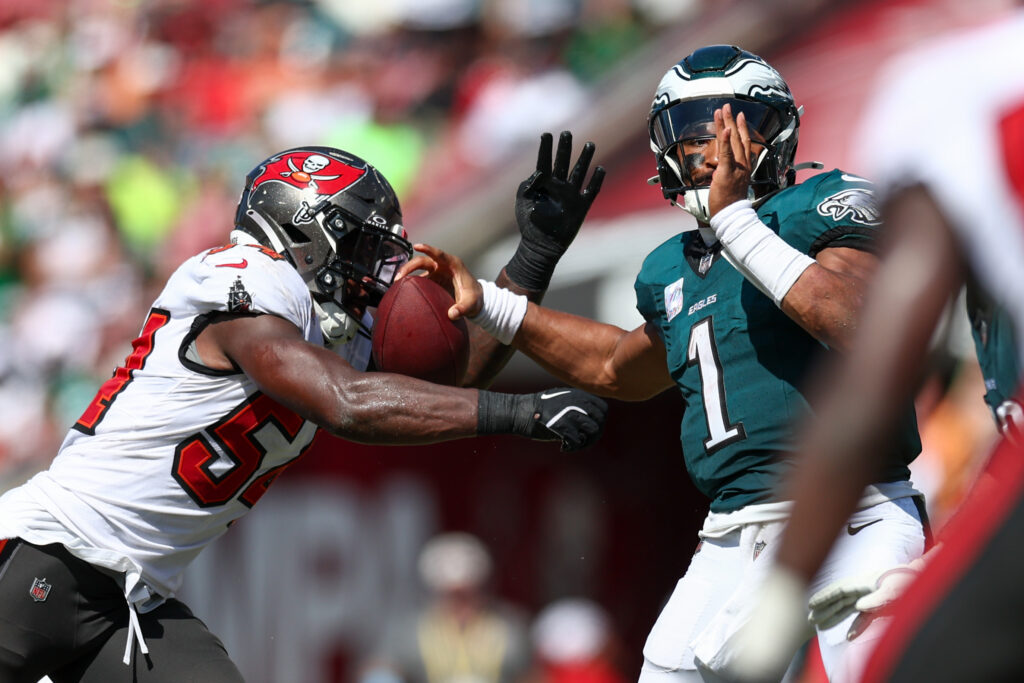
6. Buccaneers vs Eagles - A Tale of Two Pass Rushes
There was a question coming into this Eagles-Buccaneers matchup about how each team would react to the other’s pass rush. Todd Bowles has had Jalen Hurts’s number with big blitzes throughout his career. Baker Mayfield, for all the improvement he’s had in pocket management, came into the week with the highest pressure-to-sack rate and had been sacked 12 times in the past two weeks.
One team had a plan, and one did not.
The Tampa Bay Buccaneers blitzed Hurts on 29.7 percent of his dropbacks, and he was sacked five times when sending extra rushers. Still, there was some success on throws when Hurts got them off.
The Philadelphia Eagles looked less controlled when Tampa Bay didn’t blitz. Without A.J. Brown and DeVonta Smith, Hurts was pressured on 50 percent of his non-blitzed dropbacks and averaged 4.9 yards per attempt and -0.16 EPA per play.
Here’s a strip-sack from Lavante David as a late rusher but only on a four-man rush with the Eagles in the red zone in the third quarter.
Meanwhile, the Buccaneers did what they could to prevent the Eagles’ pass rush from impacting the game. Mayfield averaged 2.05 seconds to throw, and 74.5 percent of his pass attempts came within 2.5 seconds of the snap.
A release that quick basically eliminates any chance of a pass rush. There will be talk of the Eagles not generating pressure in this game, but there’s no way they could with how the Buccaneers played.
Instead, Tampa Bay decided to pick apart the holes in the Philadelphia zones. Mayfield fired accurately, targeting crossers for most of the day, and also ripped a few impressive throws into tight windows.
The 33-16 Tampa Bay win was the result of an offense with a well-thought-out game plan and another that continually looked lost.

7. The Bears defense forces turnovers
There were bullets flying at Matthew Stafford throughout the Chicago Bears’ 24-18 win against the Los Angeles Rams. With a lesser quarterback behind center, this game would have been a blowout.
Stafford did what he could behind an offensive line that was missing multiple starters while throwing to Jordan Whittington and Tutu Atwell. The Chicago defense broke through and kept the pressure on Stafford. Even though he was only pressured on 21 percent of his dropbacks, those pressures mattered.
There was a strip-sack in the second quarter with Montez Sweat pushing through the attempted block of two tight ends.
Jaquan Brikser had a fast sack off play-action early in the fourth quarter.
Jaquan Brisker sack pic.twitter.com/fA0b2Jjxaj
— Dan Pizzuta (@DanPizzuta) September 30, 2024
Brisker also had the game-sealing interception as Stafford was hit on a throw just outside his own end zone with under a minute left in the game.
.@JaquanBrisker seals the deal 🙌
— Chicago Bears (@ChicagoBears) September 29, 2024
📺: #LARvsCHI on FOX pic.twitter.com/rSyKSXTfE5
Through four weeks, the Bears are fifth in EPA per drive and turnovers per drive on defense. That’s given enough leeway for the offense to start to figure things out, which might have happened in this game.
Caleb Williams had his best performance (0.15 EPA per play), and the offense looked more in sync, especially on the ground, where there were finally some explosive plays.
At 2-2, the Bears have the Panthers and Jaguars next, which gives the real possibility of sitting at 4-2 before a Week 7 bye.
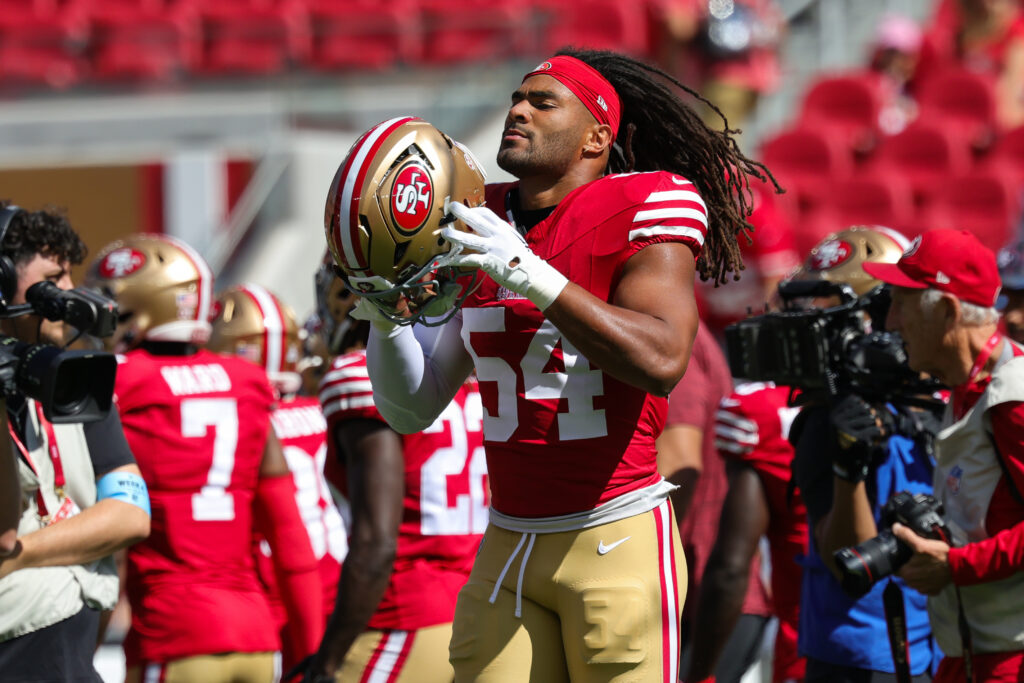
8. Player Spotlight: Fred Warner
We need to talk more about Fred Warner. He’s been widely considered the league's best linebacker for a while, but he should be in the conversation for the best defensive players overall and pushed into the Defensive Player of the Year conversation — however often those conversations happen after four weeks (for the record, he’s currently seventh in DPOY odds at +1800 on DraftKings).
Warner had another otherworldly interception in the middle of the field, his second of the season, that turned into a pick-6.
Fred Warner, man pic.twitter.com/aSPy8IFnB7
— Dan Pizzuta (@DanPizzuta) September 30, 2024
Opposing offenses often avoid throwing to the short middle of the field against the 49ers because of Warner’s presence. He’s an eraser in that area, the same way a shutdown corner can be on the outside.
So far this season, Warner has made a tackle on 23.4 percent of his run defense snaps, and 71.4 percent of his tackles have produced positive EPA, the second-best rate among linebackers with at least 15 tackles.
For a San Francisco defense that hasn’t completely found its footing so far in 2024, Warner’s play has kept them afloat.
9. Play of the day
This is everything we want to see from the Cincinnati Bengals offense.
It’s Joe Burrow hanging smartly in the pocket, a crossing route to the space beneath a two-high safety coverage, and it’s Ja’Marr Chase doing things after the catch.
If the Bengals are going to keep winning, they’re going to need explosive plays like this because the Cincinnati defense will give them up on the other side of the ball.
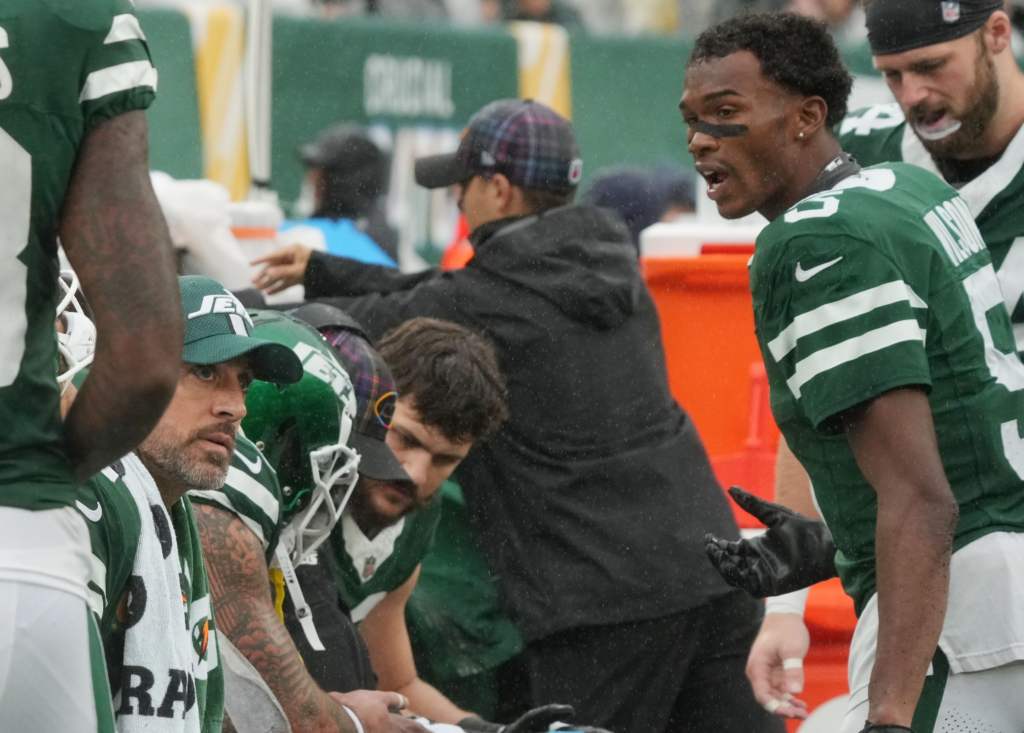
10. Broncos-Jets was a slop fest
The New York Jets and Denver Broncos, playing in rain-soaked Meadowlands, are the early leaders for the ugliest game of the year.
Bo Nix had a zero percent success rate in the first half, the worst with at least 15 attempts since at least 2000, and finished with 2.4 yards per attempt, yet the Broncos came away with a 10-9 victory. Per ESPN Stats & Info, 2.4 yards per attempt is the fewest in a win (minimum 25 pass attempts) since 1965.
Denver blitzed Aaron Rodgers and took away much of the goodwill earned from last Thursday’s Jets win against the Patriots. Rodgers was rushed, and the timing of the offense was completely off. The Broncos blitzed on 43 percent of Rodgers’s dropbacks. Against the blitz, Rodgers averaged -0.29 EPA per play, going 11-of-18 for 5.2 yards per attempt with four sacks and seven quarterback hits.
This Broncos defense remains the most aggressive in terms of straight-up blitzing, and it’s worked so far. With just enough coverage behind it, Denver could pull out some more close games. They just might have to look as ugly as this one did.


